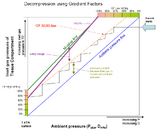Dan_P
Contributor
Hi Storker,
To the best of my knowledge, the relationship across thermal state and its effect on offgassing, is pretty much uncharted territory - that is, we have very little to go on to support whether linear or exponential, or if any "tipping points" exist.
Of course, one could argue that bodily functions rarely adapt themselves to accomodate man's preference for straight lines on a piece of paper, but that's no answer.
I was careful to phrase myself so as to be clear that this is not something I have apt substantiation to present as a fact:
("To the best of my knowledge, we'll all need to accept that there's no definitive answer to that question, whichever solution we go with. At least nothing scientifically satisfying.")
I certainly hope that I was succesful in that endeavour.
I've been trying to find conclusions, without luck, and subsequently strong datasets towards this question, for a while, also unsuccessfully.
I did, however, come across some interesting reads along the way, particularly for cold-water divers (obviously). I've added a few links below for your consideration:
Experience with moderate hypothermia in the treatment of nervous system symptoms of decompression sickness,
A. Erde.
Venous gas bubble production following cold stress during a no-decompression dive,
Dunford R, Hayward J
Effect of peripheral temperature on the formation of venous gas bubbles,
Mekjavić IB, Kakitsuba N.
Climatic and environmental factors in the aetiology of decompression sickness in divers,
Broom JR.
Best Regards,
Dan
Interesting. What kind of data and correlations do you have that supports an exponential relationship (i.e. a factor of ten for each x units of cold exposure) between cold exposure and offgassing? I'd love to see them.
To the best of my knowledge, the relationship across thermal state and its effect on offgassing, is pretty much uncharted territory - that is, we have very little to go on to support whether linear or exponential, or if any "tipping points" exist.
Of course, one could argue that bodily functions rarely adapt themselves to accomodate man's preference for straight lines on a piece of paper, but that's no answer.
I was careful to phrase myself so as to be clear that this is not something I have apt substantiation to present as a fact:
("To the best of my knowledge, we'll all need to accept that there's no definitive answer to that question, whichever solution we go with. At least nothing scientifically satisfying.")
I certainly hope that I was succesful in that endeavour.
I've been trying to find conclusions, without luck, and subsequently strong datasets towards this question, for a while, also unsuccessfully.
I did, however, come across some interesting reads along the way, particularly for cold-water divers (obviously). I've added a few links below for your consideration:
Experience with moderate hypothermia in the treatment of nervous system symptoms of decompression sickness,
A. Erde.
Venous gas bubble production following cold stress during a no-decompression dive,
Dunford R, Hayward J
Effect of peripheral temperature on the formation of venous gas bubbles,
Mekjavić IB, Kakitsuba N.
Climatic and environmental factors in the aetiology of decompression sickness in divers,
Broom JR.
Best Regards,
Dan




